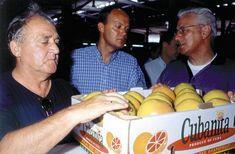
Hart & Friedmann, the UK's leading importer of Cuban citrus and handlers of the Cubanita brand from its farms in the Jagüey Grande region of Cuba, is expecting a return to form after hurricane induced problems in 2002.
H&F managing director Yossi Hecht, recognised as a pioneer of the Cuban citrus industry, has just returned from Cuba and spoke to the Journal from Rotterdam. “The fruit is looking extremely good. We have had a very pleasing production season, which has seen us reap the rewards of the heavy investment that we made in Cuba following the devastation of Hurricane Michelle, in October 2001,” he says.
The hurricane caused significant structural and financial damage to the island, ripping roves off packhouses in some areas and destroying both old and newly planted trees.
After a difficult season last time around, the results of reinvestment have been quick to manifest themselves. “Our exports will increase by 50 per cent on last year,” says Hecht. “That figure must be put into the context of a difficult season [in 2002] and it is still below what could be termed an average volume. But there is great potential in the plantations that are coming through and within three years we expect to increase to one million packages of grapefruit a year.”
Red Ruby and Marsh still dominate the portfolio, but decent volumes of Henderson and Rio Red are expected to come through in the near future. “Red grapefruit continues to expand its popularity,” says Hecht. In export terms, white grapefruit for the fresh market is almost insignificant to us.”
The UK and continental markets appear to be well-primed for Cuban grapefruit as it arrives and as it returns to form in external quality, H&F does not expect any problems for its UK customers.
Fesa is the sole UK handler of Conchita grapefruit and oranges from Cuba, both for the fresh and industrial markets.
Sales executive Colin Blake is encouraged with what he has seen so far this year. “I was in Cuba at the end of last month and the external condition of the fruit looks better than anything I have seen in the recent past. The hurricane in 2001 had a significant effect on external quality and volume last season, which led to an unsatisfactory season for everyone in the fresh market on all counts, although oranges for the processing market were not as badly affected.
There was serious consideration given to pulling out of the UK market until these issues were settled, as there is obviously no future in selling inferior quality fruit. But Conchita decided to take the bull by the horns and that commitment has produced swift results. Blake says: “Conchita has made a concerted effort and invested heavily in improving its production and packing facilities. They have spent a lot of money to provide a consistent Class I product that the buyers and the market demands.
“The long-term strategy is to improve quality in order to remove the perception that Cuban fruit is a gap-filler before Mediterranean fruit arrives. The window available for fresh fruit at the moment is 5-6 weeks, but it could be extended if skin condition is enhanced.”
There is a tendency for UK buyers to switch into Turkish grapefruit as soon as it becomes available in reasonable volumes, which sees Cuban fruit exit the market around the end of October. Blake believes advances in the external condition of Cuban fruit would strike the right balance, as the early Turkish fruit does not have optimum sugar:acid ratios. Cuban producers are capable of filling a wider window and Turkish fruit would benefit from having a little longer on the tree.
The first Cuban red grapefruit, which arrived at Fesa's Spalding facility on Thursday is, he says, coming into a “strong, firm” market. “There are gaps to fill in the red grapefruit market and early volumes will predominantly be Red Ruby,” adds Blake. “Marsh doesn't start for another 10 days, arriving on the second vessel into the UK, and there is a slight overhang of South African white grapefruit.”
Marsh represents around 25 per cent of Fesa's Cuban grapefruit offer this year and the Red Ruby volume will also be supplemented by smaller volumes of more recently planted varieties such as Henderson Star Ruby, which is a variety earmarked for success and larger volumes in the future. “The split is about right for the market. It is the way we would want it this year,” says Blake.
Cuba, along with Belize and Jamaica, have well-established niches in the European orange processing market and there is no indication that this is about to change. Fesa will bring in 16kg cartons and bulk bins of Valencia Lates from January, both for the juicers and the wholesale markets, where there is another valuable niche.
“This year is extremely important for Conchita in the UK,” says Blake. “The buyers will recognise the progress that has been made in terms of quality, but I don't expect to see the full benefits of that this year. Hopefully the long-term effect will be that in future seasons buyers will be more willing to commit to longer programmes of Cuban fruit. External condition holds the key ñ if we can reach this year's standards on a permanent basis then Cuban grapefruit will be a better commercial product for all concerned.”
From a category management point of view, including any fruit in the overall offer that is not of optimum quality is a risk. If, or maybe when, Cuba can consistently provide the aesthetic and taste qualities to delay the entry of Mediterranean fruit, the citrus category will be the winner.